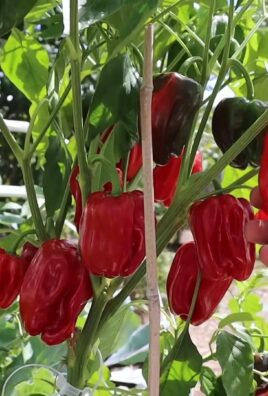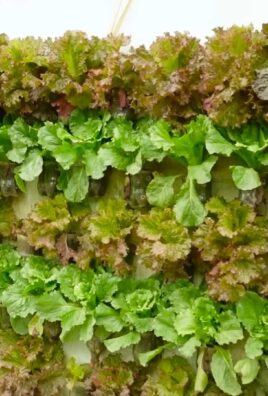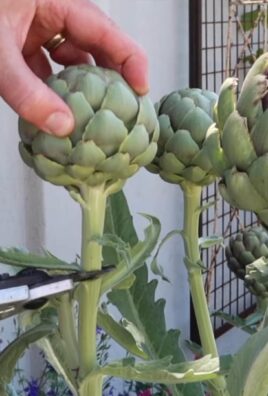Growing Sweet Corn in Containers might sound like a whimsical dream reserved for sprawling farms, but I’m here to tell you it’s absolutely achievable, even if your “farm” is a sunny balcony or a cozy patio! Forget the image of endless rows of cornfields; we’re bringing the taste of summer right to your doorstep with this surprisingly simple DIY guide.
For centuries, corn has been a staple crop, deeply woven into the cultures of indigenous peoples of the Americas. From ancient rituals to everyday meals, corn has nourished and sustained communities. Now, we’re taking this historical grain and adapting it for modern, urban living.
Why bother with growing sweet corn in containers? Well, imagine stepping outside and picking fresh, juicy ears of corn for dinner, knowing exactly where they came from and what went into growing them. No more bland, store-bought corn! Plus, it’s incredibly rewarding to nurture a plant from seed to harvest. This DIY project is perfect for anyone with limited space who craves fresh, homegrown produce. It’s also a fantastic way to teach kids about where their food comes from and the magic of gardening. So, grab your pots, soil, and seeds, and let’s get started on this exciting adventure!

Growing Sweet Corn in Containers: A Bumper Crop on Your Patio!
Hey there, fellow gardening enthusiasts! Ever dreamed of sinking your teeth into a juicy, homegrown ear of sweet corn, but thought you needed acres of farmland to make it happen? Well, I’m here to tell you that’s simply not true! You can absolutely grow sweet corn in containers, even if you only have a small balcony or patio. It takes a little planning and some extra TLC, but the reward of fresh, sweet corn right outside your door is totally worth it. Let’s dive into how you can make this happen!
Choosing the Right Corn Variety
Not all sweet corn varieties are created equal, especially when it comes to container gardening. You’ll want to opt for shorter, more compact varieties that are specifically bred for smaller spaces. Here are a few of my favorites:
* ‘On Deck’: This is a super-sweet variety that matures quickly and produces smaller ears, perfect for containers.
* ‘Golden Bantam’: A classic heirloom variety that’s known for its excellent flavor and relatively short stature.
* ‘Trinity’: Another excellent choice for containers, ‘Trinity’ is a very early maturing variety with good disease resistance.
* ‘Short Stack’: As the name suggests, this variety is bred to be short and sturdy, making it ideal for container growing.
Remember to check the seed packet for the plant’s mature height. You’re looking for varieties that stay under 5 feet tall, ideally closer to 3-4 feet.
Preparing Your Containers
The size of your container is crucial for successful corn growing. Corn plants have extensive root systems, so you’ll need a pot that’s large enough to accommodate them.
* Container Size: I recommend using a container that’s at least 12 inches in diameter and 12 inches deep. A 15-gallon container is even better, especially if you plan on planting multiple stalks per pot.
* Material: You can use plastic, terracotta, or even fabric pots. Just make sure the container has drainage holes to prevent waterlogging.
* Drainage: Good drainage is essential. Add a layer of gravel or broken pottery to the bottom of the container to improve drainage.
Choosing the Right Soil
Corn is a heavy feeder, meaning it needs a lot of nutrients to grow properly. A rich, well-draining potting mix is essential.
* Potting Mix: I recommend using a high-quality potting mix that’s specifically formulated for vegetables. Avoid using garden soil, as it can become compacted in containers and doesn’t drain well.
* Amendments: To give your corn an extra boost, amend the potting mix with compost or well-rotted manure. This will provide essential nutrients and improve drainage.
* pH Level: Corn prefers a slightly acidic to neutral soil pH, around 6.0 to 6.8. You can test your soil pH with a soil testing kit and adjust it if necessary.
Planting Your Corn
Now comes the fun part – planting your corn seeds!
1. Timing: Corn is a warm-season crop, so you’ll need to wait until the danger of frost has passed before planting. The soil temperature should be at least 60°F (15°C).
2. Sowing Seeds: Sow the seeds directly into the container, about 1 inch deep and 4-6 inches apart. I usually plant 3-4 seeds per container and then thin them out to the strongest plant once they’ve sprouted.
3. Watering: Water the soil thoroughly after planting. Keep the soil consistently moist, but not waterlogged, until the seeds germinate.
4. Germination: Corn seeds typically germinate in 7-10 days, depending on the temperature.
Caring for Your Corn Plants
Once your corn plants have sprouted, it’s important to provide them with the right care to ensure a bountiful harvest.
Sunlight
Corn needs at least 6-8 hours of direct sunlight per day. Place your containers in a sunny location where they’ll receive plenty of light. If you don’t have a sunny spot, you may need to supplement with grow lights.
Watering
Corn plants need consistent moisture, especially during hot weather. Water deeply whenever the top inch of soil feels dry to the touch. Avoid overwatering, as this can lead to root rot.
Fertilizing
As I mentioned earlier, corn is a heavy feeder. You’ll need to fertilize your plants regularly to provide them with the nutrients they need.
* Initial Feeding: After the seedlings emerge, fertilize with a balanced fertilizer (e.g., 10-10-10) diluted to half strength.
* Side-Dressing: When the plants are about 1 foot tall, side-dress them with a nitrogen-rich fertilizer (e.g., ammonium nitrate or urea). This will promote strong growth and healthy leaves.
* Flowering Stage: Once the plants start to tassel (produce male flowers), fertilize again with a balanced fertilizer to support ear development.
Pollination
Corn is wind-pollinated, meaning the pollen from the tassels needs to be transferred to the silks (the strands that emerge from the developing ears). In a container garden, you may need to hand-pollinate your corn plants to ensure good ear development.
1. Timing: Hand-pollinate in the morning, when the tassels are shedding pollen.
2. Method: Gently shake the tassels over the silks to release the pollen. You can also use a small paintbrush to collect pollen from the tassels and brush it onto the silks.
3. Repeat: Repeat the hand-pollination process for several days to ensure that all the silks are pollinated.
Staking
Corn plants can be susceptible to wind damage, especially when they’re grown in containers. Staking your plants can help to prevent them from falling over.
* Stakes: Use sturdy stakes that are tall enough to support the plants. Bamboo stakes or wooden stakes work well.
* Tying: Tie the plants to the stakes with soft twine or plant ties. Be careful not to tie the plants too tightly, as this can damage the stems.
Dealing with Pests and Diseases
While container-grown corn is generally less susceptible to pests and diseases than field-grown corn, it’s still important to be vigilant.
* Common Pests: Watch out for pests like aphids, corn earworms, and spider mites. You can control these pests with insecticidal soap, neem oil, or by hand-picking them off the plants.
* Common Diseases: Corn can be susceptible to diseases like rust and smut. Prevent these diseases by providing good air circulation, avoiding overwatering, and using disease-resistant varieties.
Harvesting Your Corn
The moment you’ve been waiting for – harvesting your homegrown sweet corn!
1. Timing: Corn is typically ready to harvest about 20-25 days after the silks emerge. The silks will turn brown and dry, and the ears will feel plump and full.
2. Testing for Ripeness: To test for ripeness, peel back a small portion of the husk and puncture a kernel with your fingernail. If the liquid that comes out is milky, the corn is ready to harvest. If the liquid is clear, the corn needs more time to mature.
3. Harvesting: To harvest, grasp the ear firmly and twist it downward. The ear should snap off easily from the stalk.
Tips for Success
Here are a few extra tips to help you grow a bumper crop of sweet corn in containers:
* Plant in Blocks: Corn is wind-pollinated, so planting in blocks rather than rows will improve pollination rates.
* Succession Planting: Plant new seeds every 2-3 weeks to extend your harvest season.
* Companion Planting: Plant corn with companion plants like beans, squash, and cucumbers. These plants can help to improve soil health and deter pests.
* Mulching: Mulch around the base of the plants with straw or wood chips to help retain moisture and suppress weeds.
* Rotate Your Crops: Avoid planting corn in the same container year after year. Rotate your crops to prevent soilborne diseases.
Growing sweet corn in containers is a rewarding experience that allows you to enjoy fresh, homegrown corn even if you don’t have a lot of space. With a little planning and care, you can have a bumper crop of sweet corn right on your patio! Happy gardening!

Conclusion
So, there you have it! Growing sweet corn in containers might seem like a challenge at first, but with the right approach, it’s an incredibly rewarding experience. Imagine stepping out onto your balcony or patio and harvesting your own fresh, juicy sweet corn – the taste is simply unmatched by anything you can buy in a store. The sweetness is intensified, the texture is perfect, and the satisfaction of knowing you grew it yourself is the ultimate garnish.
This DIY trick is a must-try for several reasons. Firstly, it democratizes access to fresh produce. Even if you don’t have a sprawling backyard, you can still enjoy the taste of homegrown sweet corn. Secondly, it’s a fantastic way to connect with nature and learn about the growing process. From planting the seeds to nurturing the seedlings and finally harvesting the ears, you’ll gain a deeper appreciation for the food you eat. Thirdly, it’s a sustainable practice that reduces your carbon footprint by minimizing transportation costs associated with commercially grown corn.
But the best part? You can customize this process to suit your own preferences and growing conditions.
Here are a few suggestions and variations to consider:
* Experiment with different varieties: While ‘Early Sunglow’ and ‘Honey Select’ are popular choices for container gardening, don’t be afraid to try other dwarf or short-season varieties. You might discover a new favorite!
* Companion planting: Consider planting basil or marigolds around your corn plants. These companion plants can help deter pests and attract beneficial insects.
* Succession planting: Plant a new batch of seeds every few weeks to extend your harvest season. This way, you’ll have a continuous supply of fresh sweet corn throughout the summer.
* Vertical gardening: If you’re short on space, explore vertical gardening options. You can use trellises or other supports to train your corn plants to grow upwards.
* Soil Amendments: Consider adding Mycorrhizae to the soil at planting. These beneficial fungi will help the corn roots absorb nutrients and water more efficiently.
Ultimately, the key to success with growing sweet corn in containers is to provide your plants with plenty of sunlight, water, and nutrients. Don’t be afraid to experiment and learn from your mistakes. Every growing season is a new opportunity to improve your skills and refine your techniques.
We wholeheartedly encourage you to give this DIY trick a try. It’s a fun, educational, and delicious way to bring a little bit of the farm to your home. And most importantly, we want to hear about your experience! Share your photos, tips, and challenges in the comments below. Let’s create a community of container corn growers and learn from each other. Happy growing!
Frequently Asked Questions (FAQ)
1. What is the best container size for growing sweet corn?
The ideal container size for growing sweet corn is at least 12 inches in diameter and 12 inches deep, but larger is generally better. A 15-20 gallon container is a good starting point. Sweet corn plants have extensive root systems, and a larger container provides ample space for them to develop. Insufficient space can lead to stunted growth and reduced yields. Make sure the container has drainage holes to prevent waterlogging, which can also harm the plants. Remember that you’ll need to plant multiple corn stalks together for proper pollination, so a larger container will accommodate this better.
2. How many sweet corn plants can I grow in one container?
For optimal pollination and yield, plant at least 3-4 sweet corn plants together in a single container. Sweet corn is wind-pollinated, so planting multiple plants close together increases the chances of successful pollination. If you’re using a larger container (15-20 gallons or more), you can potentially plant up to 5-6 plants, but be sure to monitor their growth and provide adequate nutrients and water. Overcrowding can lead to competition for resources and reduced yields.
3. What type of soil is best for growing sweet corn in containers?
A well-draining, nutrient-rich potting mix is essential for growing sweet corn in containers. Avoid using garden soil, as it can become compacted in containers and hinder drainage. A good potting mix should contain a blend of peat moss, perlite, and vermiculite. You can also amend the potting mix with compost or aged manure to provide additional nutrients. Sweet corn is a heavy feeder, so it’s important to use a soil that can provide the necessary nutrients for healthy growth and ear development.
4. How often should I water my container-grown sweet corn?
Water your container-grown sweet corn regularly, especially during hot and dry weather. The soil should be kept consistently moist, but not waterlogged. Check the soil moisture level daily by sticking your finger into the soil. If the top inch of soil feels dry, it’s time to water. Water deeply, allowing the water to drain out of the drainage holes. Avoid overhead watering, as this can increase the risk of fungal diseases. During the peak growing season, you may need to water your corn plants daily, or even twice a day in very hot weather.
5. What kind of fertilizer should I use for sweet corn in containers?
Sweet corn is a heavy feeder and requires regular fertilization to produce healthy plants and plump ears. Use a balanced fertilizer (e.g., 10-10-10) at planting time, and then side-dress with a nitrogen-rich fertilizer (e.g., ammonium nitrate) when the plants are about 12 inches tall and again when the tassels appear. Follow the instructions on the fertilizer package carefully to avoid over-fertilizing, which can burn the plants. You can also use organic fertilizers, such as compost tea or fish emulsion, to provide nutrients to your corn plants.
6. How much sunlight does sweet corn need?
Sweet corn requires at least 6-8 hours of direct sunlight per day to thrive. Choose a location for your container-grown corn that receives plenty of sunlight throughout the day. If you live in a particularly hot climate, you may need to provide some afternoon shade to prevent the plants from overheating. Insufficient sunlight can lead to stunted growth, poor ear development, and reduced yields.
7. How do I know when my sweet corn is ready to harvest?
Sweet corn is typically ready to harvest about 20-25 days after the silks emerge. The silks should be brown and dry, but still slightly moist. The kernels should be plump and milky when pierced with a fingernail. To check for ripeness, peel back a portion of the husk and puncture a kernel with your fingernail. If the liquid is milky, the corn is ready to harvest. If the liquid is clear, the corn needs more time to mature. If the liquid is doughy, the corn is overripe. Harvest the ears by twisting and pulling them downwards from the stalk.
8. What are some common pests and diseases that affect sweet corn?
Common pests that affect sweet corn include corn earworms, aphids, and spider mites. Diseases that can affect sweet corn include corn smut, rust, and leaf blight. Monitor your plants regularly for signs of pests or diseases and take action promptly to prevent them from spreading. You can use organic pest control methods, such as insecticidal soap or neem oil, to control pests. To prevent diseases, ensure good air circulation around your plants and avoid overhead watering.
9. Can I grow sweet corn in containers indoors?
While it’s possible to grow sweet corn indoors, it’s generally not recommended. Sweet corn requires a lot of sunlight and space, which can be difficult to provide indoors. If you do attempt to grow sweet corn indoors, you’ll need to use grow lights to supplement natural sunlight and provide adequate ventilation. You’ll also need to hand-pollinate the plants, as there won’t be any wind or insects to do it for you.
10. What are some tips for successful pollination of container-grown sweet corn?
Since container-grown sweet corn may not be exposed to as much wind as corn grown in a field, it’s important to take steps to ensure successful pollination. You can hand-pollinate the plants by gently shaking the tassels to release pollen and then brushing the pollen onto the silks. Do this in the morning, when the silks are most receptive. You can also plant multiple corn plants close together to increase the chances of pollination. Make sure to provide adequate water and nutrients to support healthy tassel and silk development.





Leave a Comment